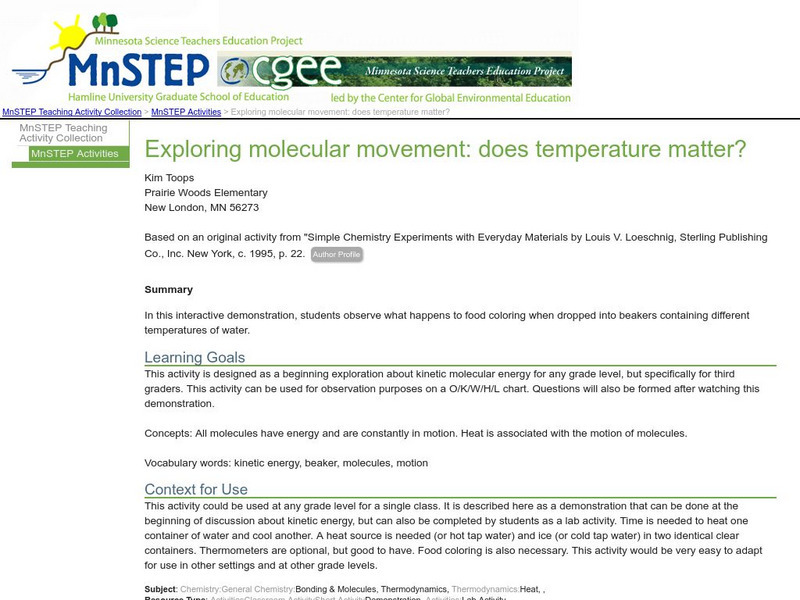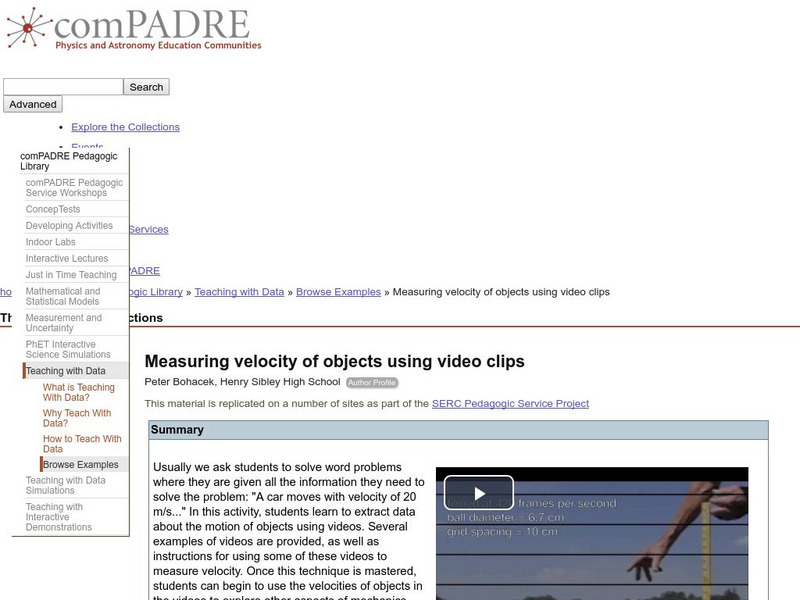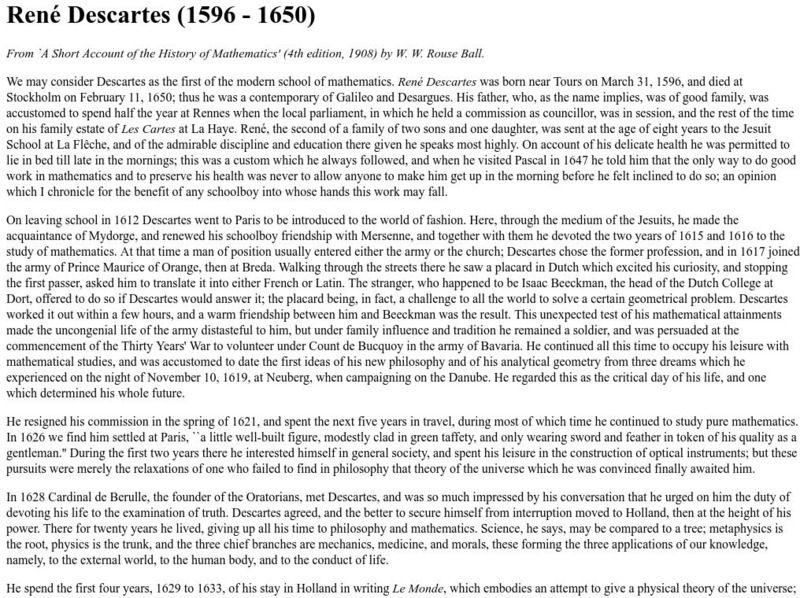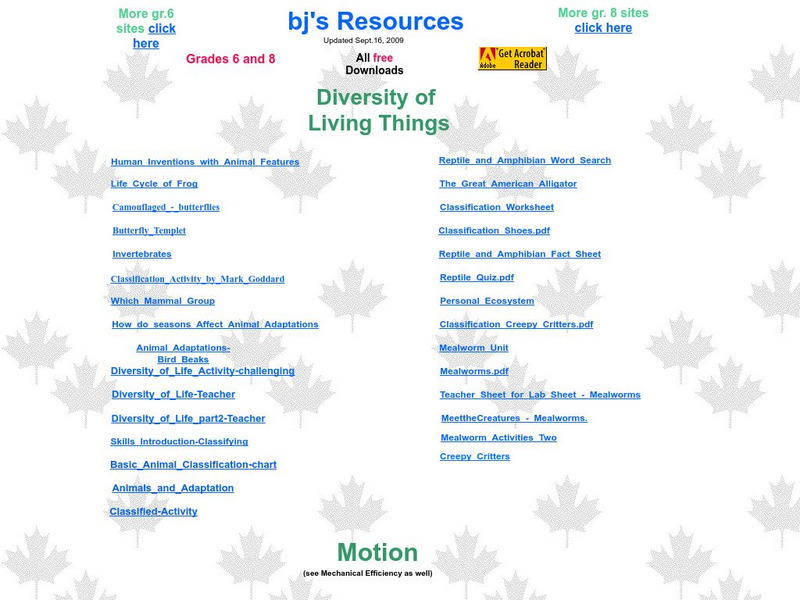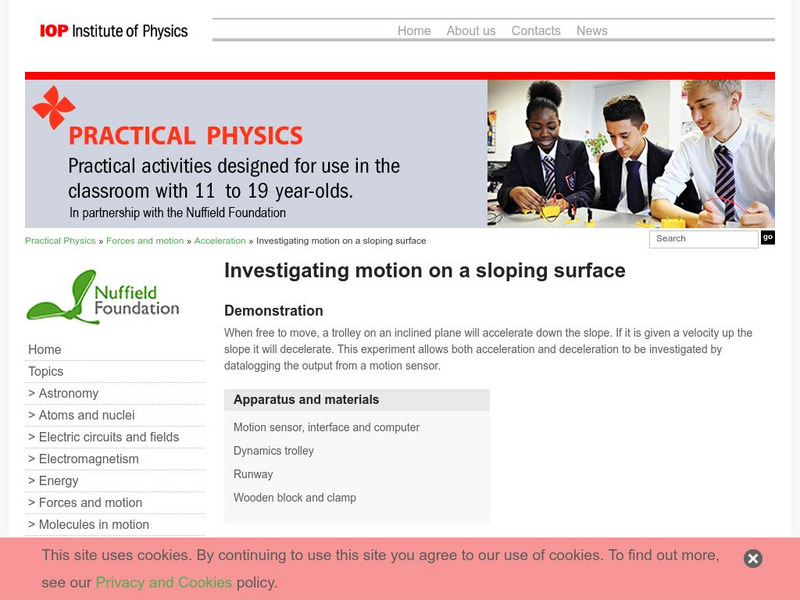Science Education Resource Center at Carleton College
Serc: Investigating Motion: Paths of a Marble
In this activity, children will investigate the paths that marbles take once set into motion and then how to change those paths, noting if and how they change.
Science Education Resource Center at Carleton College
Serc: Exploring Molecular Movement: Does Temperature Matter?
In this interactive demonstration, students observe what happens to food coloring when dropped into beakers containing different temperatures of water.
Science Education Resource Center at Carleton College
Serc: Using Your Marbles: Making Energy Work for You
This activity is based on the common experiment of running a marble down a ramp to do work on a cup. Students will be able to see the relationship between mass and energy of the marble and the ramp height.
Science Education Resource Center at Carleton College
Serc: Graph Predictions for Position, Velocity and Acceleration
Students interactively create predictions of position, velocity, and acceleration graphs using java applets. The applets automatically classify student answers, so instructors can create graphs of student predictions.
Science Education Resource Center at Carleton College
Serc: Measuring Velocity of Objects Using Video Clips
In this activity, students learn to analyze video clips and extract data about the velocity of moving objects, reinforcing the concept of average velocity. After mastering the technique of using videos to measure velocity, students can...
TryEngineering
Try Engineering: Getting Your Bearings
Students learn about teamwork and problem solving in this lesson that focuses on friction and how ball bearings are used to reduce it.
TryEngineering
Try Engineering: Give Me a Brake
Activity investigates the concept of how bicycle brakes use force and friction to stop or slow mechanical motion. Students work in teams to devise a simple braking system while suggesting improvements to current bicycle brake design.
TryEngineering
Try Engineering: A Question of Balance
Students work in teams to fill jars with a product that is uniform in weight or count. Lesson investigates how manufacturing engineers use weight scales and measurement to develop systems that can create consistent products.
TryEngineering
Try Engineering: Simple Kitchen Machines
Team lesson focuses on the different types of simple machines, how they work, and how they can be found in daily life.
TryEngineering
Try Engineering: Shake It Up With Seismographs
During this lesson, students learn how seismographs work and how technology has impacted the world by helping save lives from earthquakes. They will work in teams to design, test, and evaluate the results of their own seismographs, then...
TryEngineering
Try Engineering: Tinkering With Tops
Lesson explores the history, design, and motion of spinning tops. Student teams design and build their own tops that can spin for at least 10 seconds within a circle 30 centimeters in diameter.
TryEngineering
Try Engineering: Chair Lift Challenge
Lesson investigates how engineers develop safe transportation systems to operate in a variety of climates and environments. Teams of students work together to construct a "chair lift" made from everyday materials as a test of this...
TryEngineering
Try Engineering: Engineered Sports
Learners work in teams to investigate how aerospace engineering relates to sports, especially golf ball design and the physics of bounce. They use this information to determine whether these aerospace principles can be applied to...
ArtLex
Art Lex: Movement
This site from Artlex is a fantastic description of how movement is used in the creation of art. There are links to works of art in sculpture, painting and photography as well as focused interpretations of how different types of movement...
Physics Games
Physics Games: Bubble Quod
You're in a bubble and that pointy thing in each level is your only ticket to freedom. Don't let any obstacles stand in your way!
Project Britain
Primary Homework Help: Forces Quiz
First, read some fast facts about forces, then take a ten-question, multiple-choice quiz. Check to see if your answers are correct after each question.
Physics Classroom
The Physics Classroom: 1 D Kinematics: Table of Contents
Learners examine motion with words, equations, diagrams, and graphs. Some topics investigated are position, velocity, acceleration, and free fall. The tutorial consists of lessons and problems to check for understanding.
American Association of Physics Teachers
Com Padre Digital Library: Open Source Physics: Car Race Model
Check out this simulation of kinematics. Test a race car with a constant acceleration versus a race car with constant velocity.
TED Talks
Ted: Ted Ed: The Invisible Motion of Still Objects
Ran Tivony describes how and why molecular movement occurs and investigates if it might ever stop. [4:44]
Open Curriculum
Open Curriculum: Analysis of Forces
This study information helps students apply Newton's third law and understand forces.
Open Curriculum
Open Curriculum: Newton's Laws in Three Dimensions
Students can use this article to learn about forces and motions in three dimensions.
Trinity College Dublin
Trinity College: Rene Descartes (1596 1650)
Events of Rene Descartes' life are presented in a timeline form. The biographical information is taken from "A Short Account of the History of Mathematics" by W. W. Rouse Ball (4th Edition, 1908).
My Science Site
Life Systems: Cells, Tissues, Organs
Extensive site for teachers provides some helpful resources that pertain to plant and animal cells. Includes a microscope diagram as well as plant, animal and pond labs. Also contains links to structures and mechanisms, matter and...
Other
Institute of Physics: Practical Physics: Investigating Motion Sloping Surface
This experiment allows both acceleration and deceleration to be investigated by data logging the output from a motion sensor.



